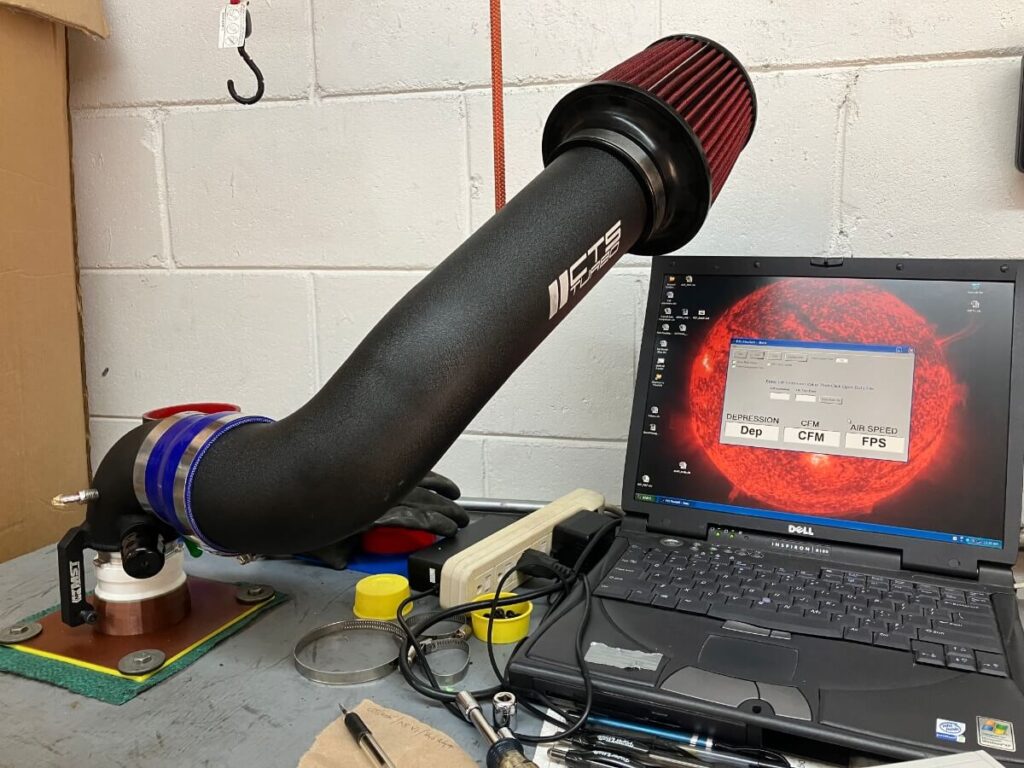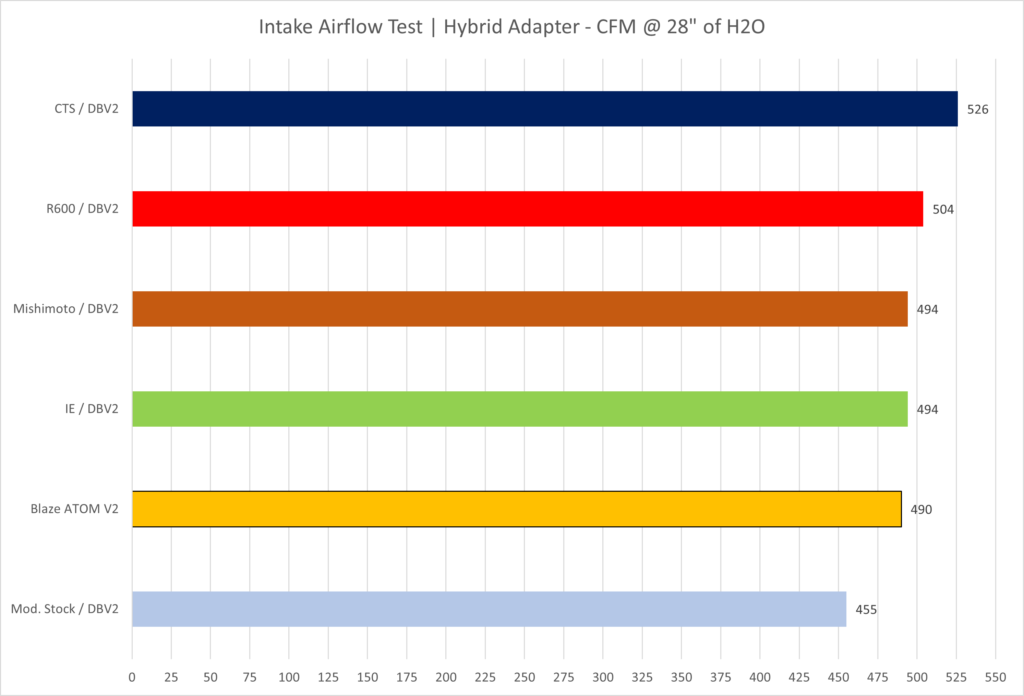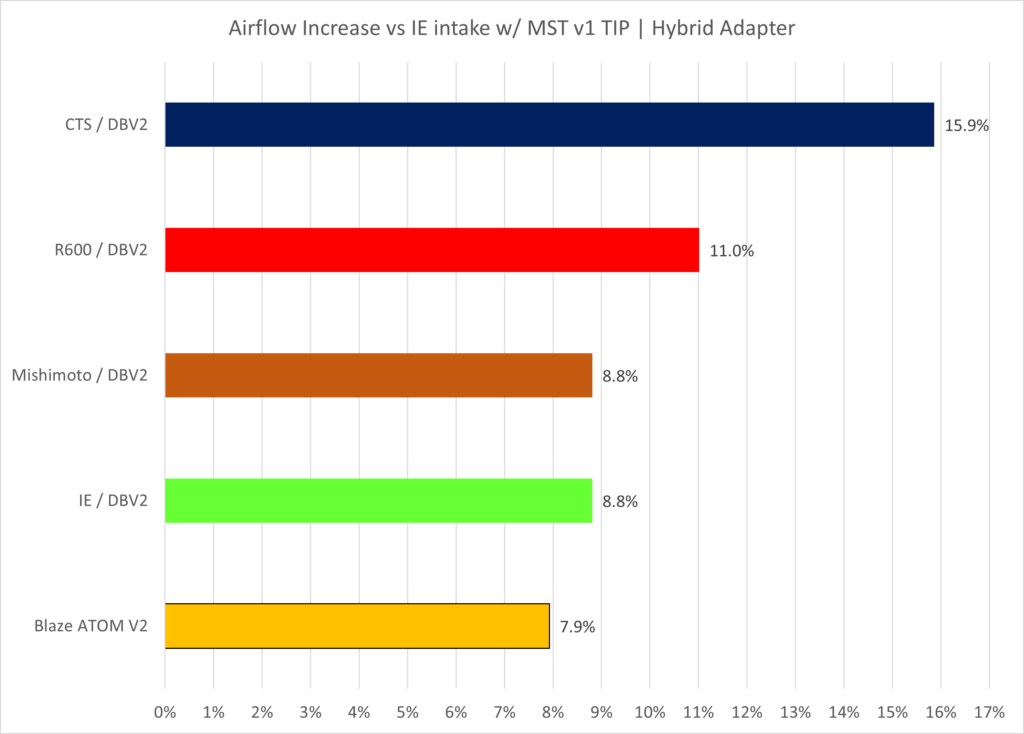Background:
Previously a post was made that showed how using a Hybrid optimized turbo inlet elbow made a significant difference to airflow through an Integrated Engineering intake when used in conjunction with a larger turbo compressor housing inlet.

This post continues an investigation of the effectiveness of the DBV2 turbo inlet elbow for increasing airflow through a selection of other intakes for the Mk7.
The intake products being tested are from Racingline, Mishimoto, CTS Turbo, and the VW OEM stock Mk7 intake with some modifications made to it.

The Racingline R600 with cotton air filter and the foam filter sock is joined to the DBV2 turbo inlet elbow using an MST inlet hose. The MST hose is used in place of the Racingline hose because the Racingline hose is sized to work with a stock TIP inlet, and the DBV2 is a 3″ inlet.

The Mishimoto intake has a built-in inlet “hose” that is connected to the DBV2 TIP with a 3″ silicone coupler. The Mishimoto intake is supplied with a silicone coupler that is sized to fit with the Mishimoto TIP, which is built with a stock inlet size diameter.

The CTS Turbo intake is attached to the MST and DBV2 TIPs using a 3.5″ to 3″ silicone reducer. The MST TIP was also tested to see how airflow compared to the case with the DBV2 TIP.

A modified stock airbox, with the baffle/grate removed and an aFe filter installed is attached to the DBV2 TIP using the MST inlet hose.
Test Procedure:
The flow bench calibration is first checked and then an adapter is attached that simulates the inlet of a hybrid turbocharger with a 56 mm inlet.

Note: There are two hybrid adapters used during this testing, the brown and white version shown above has a slightly smaller inside diameter where the TIP fits into the adapter. This is because the MST and DBV2 TIP are slightly different in size, with different size o-rings, and the DBV2 doesn’t fit easily into the brown/white adapter, and the MST is slightly loose when inserted into the purple/orange adapter. The throat of each adapter is the same 56 mm diameter.
With the adapter in place, each intake is assembled with the appropriate intake hose or silicone coupler and then attached to the DBV2 TIP.
The entire intake assembly is then placed in the adapter and supported to maintain the correct position.
The flow bench is operated at a depression of 28″ of H2O and the airflow through the intake is measured and recorded at this depression.
Test Results:
The airflow through each intake is listed below:
- R600 – 504 CFM @ 28″ of H2O
- Mishimoto – 494 CFM @ 28″ of H2O
- CTS Turbo – 526 CFM @ 28″ of H2O
- CTS Turbo w/ MST v2 TIP – 512 CFM @ 28″ of H2O
- Modified stock – 455 CFM @ 28″ of H2O
These measurements are shown on the chart along with the previous measurements taken of the IE V2 intake with DBV2 TIP and the Blaze Performance intake.

Conclusions:
In the previous post, it was shown that the airflow through the IE V2 intake was increased substantially when replacing a stock-size turbo inlet pipe with a hybrid optimized turbo inlet pipe when testing with a hybrid-size turbo adapter.
The baseline intake configuration was the IE V2 intake with TIP sized for use with a stock (49 mm inlet) turbocharger compressor housing.
The chart below shows the airflow difference between that baseline and other intakes that have been tested using the hybrid turbo adapter (56 mm inlet).

Each of the tested intakes, when used with the DBV2 TIP, shows a significant airflow increase over the baseline case.
Differences in airflow between the aftermarket intakes are less than the differences in airflow resulting from the change from a stock-size TIP to a hybrid-size TIP.
Noteworthy results from this test are the CTS Turbo and DBV2 combination flowing approximately 72 CFM more than the baseline test case.
This increase is approximately 7.3% greater than the Blaze intake, which is approximately the same as the increase the Blaze intake has over the baseline case, 7.9%.
Blaze compared with the baseline case was the subject of the IE Intake Advice post. In that scenario, the EQT customer saw a 13 whp gain with the Blaze intake, over the baseline case.
The results measured in this test suggest that there is potentially an additional 13 whp to be realized with the CTS Turbo/DBV2 combination over the Blaze intake.

CTS, simple yet effective.
Yes, a filter stuck on the end of a mostly straight pipe is tough to beat.